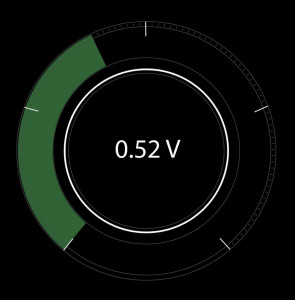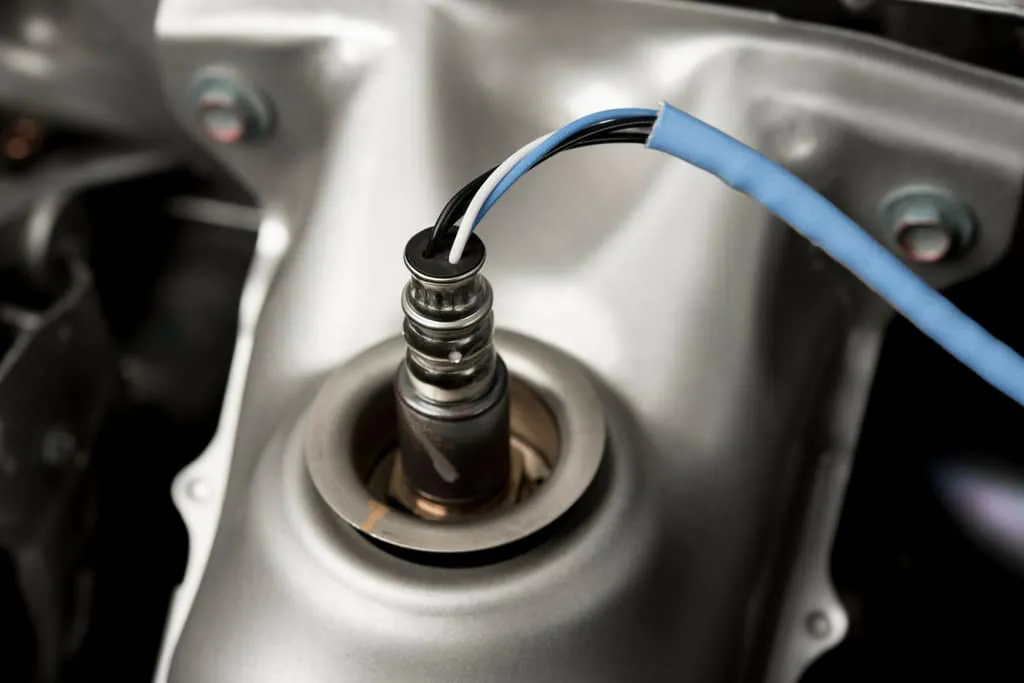What Do O2 Sensors Do?
02 sensors measure the amount of oxygen in the exhaust and report the level to your vehicle’s computer. There are O2 sensors before and after the catalytic converter. The upstream O2 sensor controls how much fuel is added to the air/fuel mixture. The downstream O2 sensor makes sure the catalytic converter is working.
If the fuel ratio is lean (not enough fuel in the mixture), the voltage is relatively low — approximately 0.1 volts. If the fuel ratio is rich (too much fuel in the mixture), the voltage is relatively high — approximately 0.9 volts. When the air/fuel mixture is at the stoichiometric ratio (14.7 parts air to 1 part fuel), the oxygen sensor produces 0.45 volts.
Learn the difference between rich and lean fuel mixtures. Proper air fuel ratio is critical to keeping your car running as smoothly as it should be.
Where are Oxygen Sensors Located?
Every car made after 1996 has an O2 sensor upstream and downstream of each catalytic converter. Most vehicles have two O2 sensors. There can be 4 O2 sensors depending on your engine and exhaust. V6 and V8 engines with dual exhaust have four oxygen sensors. A pair of O2 Sensors for each bank of the engine.
Bad O2 Sensor Symptoms
Symptoms of a faulty O2 sensor may include the following:
- Lean or rich running condition
- Poor acceleration
- Engine hesitation
- Black smoke from tailpipe (rich running condition) black smoke is excess fuel exiting the exhaust
- Rough idle
- Vehicle stalling out
- Reduced fuel efficiency
When an O2 sensor fails it will usually trigger your check engine light to turn on. An O2 sensor can fail for many reasons. Use an OBD2 scanner like FIXD to see the specific fault code that triggered the check engine light. Based on this fault code, it will point to how it failed and then move forward with the diagnosis.
You can also use the FIXD Sensor and app to measure the voltage of the O2 sensors and determine if they are faulty and need to be replaced. This will help you understand the root cause of your problem.
Problem Symptoms Fault Code
Upstream O2 sensor circuit malfunction Decrease in MPG, Increased tailpipe emissions, asymptomatic sometimes P0130
Low upstream O2 sensor voltage Lack of power, Vehicle running rough, Exhaust odor, asymptomatic sometimes P0131
High upstream O2 sensor voltage Vehicle running rough, Lower fuel economy P0132
Downstream O2 sensor circuit malfunction Decrease in MPG, Increased tailpipe emissions, asymptomatic sometimes P0136
Low downstream O2 sensor voltage Lack of power, Vehicle running rough, Exhaust odor, asymptomatic sometimes P0137
High downstream O2 sensor voltage Lower fuel economy, rough idle, strong fumes P0138
Faulty oxygen sensor (lean) Lack of power from the engine, rough idle, engine coughing/misfiring, tips of spark plugs are white P0171
Faulty oxygen sensor (rich) Lack of power from the engine, rough idle, engine hesitation/misfiring, soot buildup on spark plug diode P0172
Faulty catalytic converter (possibly due to broken O2 sensor) A lack of power from the engine, decreased fuel efficiency, rotten egg or sulfur smell P0420
O2 Sensor Voltage Range
Sensor Name Location Voltage Range Reasons For Being Out Of Range
Upstream O2 Sensor/Bank 1 Sensor 1 Between the exhaust manifold and the catalytic converter The voltage should fluctuate between 0.1V and 0.9V If the voltage never exceeds 0.75V, the air/fuel mixture is lean
If the voltage never drops below 0.25, the air/fuel mixture is rich
If the voltage is steady, there is probably a problem with the sensor itself
Downstream O2 Sensor/Bank 1 Sensor 2 Between the catalytic converter and the muffler The voltage should be steady at about 0.45V If the voltage is steady and high there is a lack of oxygen in the air/fuel mixture
If the voltage is steady and low, there is too little oxygen in the air/fuel mixture
If the voltage is fluctuating like the upstream O2 sensor, the catalytic converter may be broken


O2 sensors only work once they have heated up to over 600 degrees. When you start a cold engine, or if an oxygen sensor fails, the O2 sensor does not regulate the fuel mixture. Instead, your car uses a fixed rich fuel mixture until it gets a signal from the O2 sensor. While the car isn’t getting a signal from the sensor it has increased fuel consumption and emissions. Many newer oxygen sensors contain heating elements. This helps to get them to operating temperature faster. This decreases the amount of time your car spends running inefficiently.
Upstream O2 Sensor (Bank 1 Sensor 1)
O2 sensor 1 can also be called the upstream O2 sensor or bank 1 sensor 1. It is after the exhaust manifold and before the catalytic converter. It measures the air-fuel ratio of the exhaust coming out of the exhaust manifold to maintain the 14.7:1 fuel to oxygen ratio.
When the O2 sensor has a low voltage (lean) signal, it compensates by increasing the amount of fuel in the mixture. When the O2 sensor has a high voltage (rich) signal, it reduces the amount of fuel the car adds to the mixture.
The upstream O2 sensor regulates the ratio of the fuel mixture by flip-flopping between rich and lean mixtures. This allows the catalytic converter to lower emissions by keeping the average ratio of the fuel mixture in proper balance.
Downstream O2 Sensor (Bank 1 Sensor 2)
O2 sensor 2 can also be called the downstream O2 sensor or bank 1 sensor 2. It is after the catalytic converter and before your muffler. It makes sure the catalytic converter is healthy and working properly. The catalytic converter should output a steady amount of oxygen so the voltage on O2 sensor 2 should be steady.
When everything is working correctly, there should be a 14.7:1 oxygen to fuel ratio. When your car is able to maintain this ratio, the downstream O2 sensor should read about 0.45V. If the O2 sensors, catalytic converter, or fuel injectors are damaged the downstream O2 sensor voltage could be higher or lower. A higher voltage means there is too much fuel in the mixture. A lower voltage means there is too much oxygen in the mixture.
How to Test Oxygen Sensors
Since the O2 sensor plays an important role in keeping your engine running as efficiently and cleanly as possible, it’s important to make sure that it’s working properly. Most oxygen sensors typically last 30,000 to 50,000 miles, or 3-5 years, with newer sensors lasting even longer with proper maintenance and upkeep. The cost to replace an oxygen sensor ranges from $155-$500, depending on if you DIY or go to a shop. You can check out our full cost guide here.
You can test the oxygen sensor at home with a voltmeter or OBD2 scan tool like the FIXD Sensor. Go to the live data feed within the FIXD app to see the voltage and response time of your O2 sensors. Click here to see what else FIXD has to offer.
Typically, a front (upstream) O2 sensor 1 that is functioning properly will be switching from rich to lean at a fairly steady rate, creating a wavelike formation. The voltage generated from the O2 sensor should be from 0.1V to 0.9V, with 0.9V on the rich side and 0.1V on the lean side. If your readings are within this range, the O2 sensor is functioning properly.
The rear (downstream) oxygen sensor 2 is a catalyst monitor and if everything is operating normally, this sensor will be hovering around half a volt. However, this measurement can fluctuate depending on the manufacturer.
Additional O2 Sensor Testing Tips
If the O2 Sensor is not responding quickly to testing:
If the sensor seems sluggish or slow to respond during testing and there are other symptoms without a fault code, this may be an issue of a “lazy” O2 sensor that can cause other problems.
If the O2 Sensor voltage is sticking rich or lean:
Try introducing the opposite condition to determine if the issue is with the oxygen sensor or if it’s an air-fuel mixture issue. For example, if your O2 sensor is sticking lean, add fuel to the situation to see if it responds. If the O2 sensor is on the rich side, try introducing a vacuum leak or more oxygen to see how and if the sensor responds.
How Do O2 Sensors Work?
Oxygen sensors work by producing their own voltage when they get hot (approximately 600°F). On the tip of the oxygen sensor that plugs into the exhaust manifold is a zirconium ceramic bulb. The inside and the outside of the bulb is coated with a porous layer of platinum, which serve as the electrodes. The interior of the bulb is vented internally through the sensor body to the outside atmosphere.
When the outside of the bulb is exposed to the hot gases of the exhaust, the difference in oxygen levels between the bulb and the outside atmosphere within the sensor causes voltage to flow through the bulb.
Stay in the Know with the FIXD Sensor & App
With the FIXD car scanner and app, you can take control of car care and save $1000s. From automatic maintenance alerts sent straight to your phone, to real-time data showing fuel trims, oxygen sensor levels, battery voltage, & more, FIXD keeps you informed so you can extend the life of your vehicle and avoid unnecessary upsells. Learn more about the FIXD OBD2 scanner and app today!

Recovering autocross and track day enthusiast. Once turned a VW Jetta into a pickup truck. Lives in a van down by the river. Dream car: 2001 Subaru WRC rally car.














